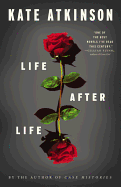
On a snowy night in 1910, Ursula Todd is born blue in the face, strangled by her own umbilical cord, never taking her first breath; on a snowy night in 1910, the local doctor arrives at Mrs. Todd's bedside just in time to save Ursula's life.
In 1930, Ursula Todd walks into a restaurant and shoots Hitler at point-blank range; in 1930, she is wed to an abusive husband in England.
In 1933, Ursula Todd weds a German man and settles in Germany, unable to leave the country after war begins in 1939; in 1940, she is having an affair with a British government official in London.
Kate Atkinson's Life After Life is the story of Ursula Todd's many, many lives, all starting in the same place, at the same time, but varying by degrees. She lives through the Second World War again and again: as a friend of Hitler's mistress, as a member of London's air raid patrol, as a government worker. She loses siblings, parents, friends, lovers. She sees families torn apart, city blocks destroyed, "the crushed fragments of lives, never to be whole again."
It is only natural, then, that Ursula begins to question her ability to change the past--and therefore the future. Atkinson details the implications of a life lived over and over again: Are our fates locked in, or do we have the power to change them?
The success of Life After Life lies in Atkinson's ability to parse these cerebral questions of life and philosophy without ever losing sight of Ursula's story--or stories. The result is stunning, emotional, at times funny--and downright unforgettable. --Kerry McHugh, blogger at Entomology of a Bookworm

